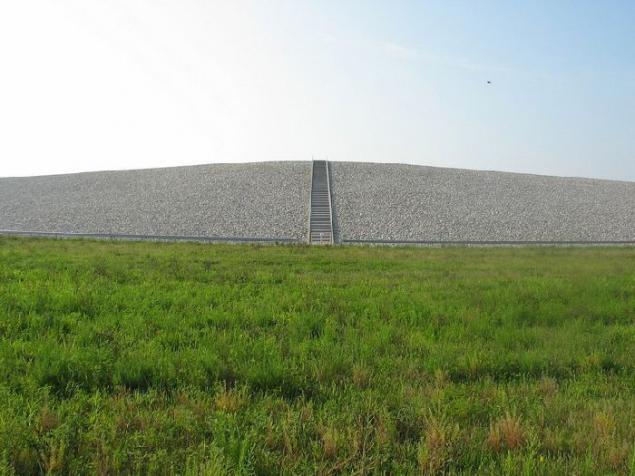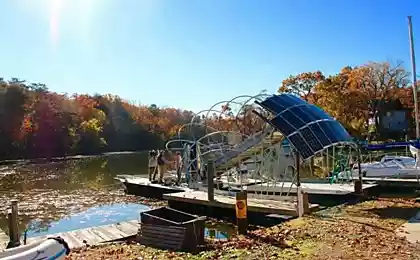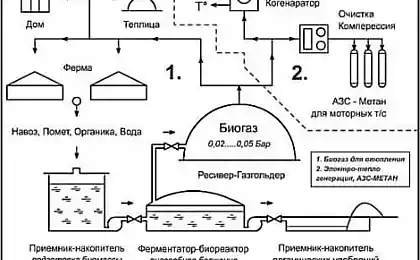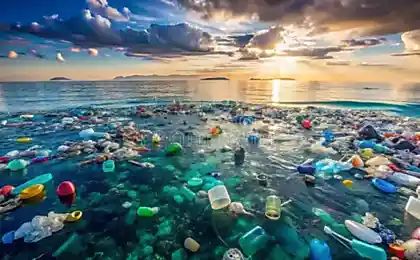714
Dome Runit - radioktivnym trash (19 photos)
Do you think that is? Maybe a flying saucer landed? Or dug up from ancient times? You see, over there, and people walk on it ... Now I'll tell you more ...

Since the Second World War, the United States spent more than 1, 000 nuclear tests, mainly at the Nevada test site of the Pacific Proving Grounds in the Marshall Islands and other locations around the continent. More than 100 of these trials have taken place in the Pacific Ocean, the Marshall Islands, among them the Eniwetok Atoll.
Enewetak Atoll - a large coral atoll of 40 islands in the Pacific Ocean, located 305 kilometers west of Bikini Atoll. He was the chief test bed for nuclear weapons since World War II. Before Enevatak came under the control of the United States, he was under Japanese control. They used the atoll as a stopover for refueling aircraft. After the seizure was the main Enevatak advanced naval base for the US Navy. Then, the island was evacuated, and the nuclear tests began.

Between 1948 and 1958, the atoll has experienced 43 explosion, including the first hydrogen bomb test in late 1952 as part of Operation Ivy, during which completely disappeared from the face of the earth island Elugelab.
In 1977 the program began decontamination island Enevatak.
In 1980, on the island Runit (Eniwetok Atoll, Marshall Islands) was completed "Kaktuskupola" sarcophagus over the funnel of the test vosemnadtsatikilotonnoy bomb code-named "Cactus", conducted by the Americans on May 5 1958go in a series of explosions, known as «Operation Hardtack I» . The sarcophagus over a hundred meters in diameter covered svezennuyu in this artificial crater around the atoll radioactive soil. The diameter of the dome corresponds to the diameter of the funnel cactus

But here's the rub Near the sarcophagus, in shallow water, a funnel is from the explosion of another bomb sorokakilotonnogo "Lacrosse" undermined the 5th of May, but two years before the "Cactus" in the «Operation Redwing». The idea is that the difference in size should be more noticeable, but in reality it is hardly visible and is just over 10 meters. There is no deception and arts with photoshop. "Lacrosse" turned to dust reef, the destruction of part of the energy is gone, well, digging craters took the rest.

Within three years, the armed forces mixed more than 85, 000 cubic meters of contaminated soil with Portland cement and buried in a crater 350 feet wide and 30 feet deep, at the northern end of the island atoll Runit. Final cleaning cost of the project was $ 239 million.
After the completion of the dome of the United States government announced the south and west of the island in the atoll safe for habitation in 1980, and residents of Enewetak returned home. Today, you can visit with a tour of the dome.


Speaking of the Arts. The guys from "Bikini Line" decided to turn "Kaktusdoum" a huge picture, which will be visible from space and gaining command. With charitable purposes to help children affected by the earthquake and tsunami in Japan.



But there is a store in the United States:

Between 1940 and 1941, the US Army bought 17 000 acres of land in the district of Saint Charles, outside St. Louis. In this area, there were three nice town - Hamburg, Howell and Tunervilla. They were immediately evacuated. Hundreds of homes, businesses, churches and schools in the area were destroyed, or, in a few months, ceased to exist, all three of the city. Massive factory was established to produce TNT and DNT, to supply the Allied forces during the Second World War. The operation had been hired more than 5, 000 people. By the time when the plant ceased production August 15, 1945, he produced more than 700 million pounds of TNT.

After the war, the army began to sell part of the land. Missouri was 7, 000 acres, while the University of Missouri bought another 8, 000 acres. These areas are today Memorial Reserve and the Bush Weldon Spring. A small piece of land - about 2, 000 acres - has been retained by the Commission on the US Atomic Energy. Here, the company set up processing uranium ore in 1955.

Processing plant operated until 1966. During the Vietnam War, the army planned to use part of the old plants prepare uranium to produce Agent Orange, a herbicide which deprives the jungle foliage during the war. The army later abandoned the plan was never produced chemical in Weldon Springe. The factory was in ruins for more than 20 years, but still contain contaminated equipment and dangerous chemicals. Waste containers were filled with thousands of gallons of water contaminated with radioactive waste and heavy industrial metals.

Since the 1980s, the US Department of Energy began an extensive disinfection of the area, eventually creating a giant waste repository to bury waste materials. The official name of the place - WSSRAP.

Completed in 2001, the mountainous structure covers 45 acres and holds 1.5 million cubic yards of hazardous materials. The staircase leads to the top of the cell, where there is a viewing platform and plaques that provide information about the area and its history. Visitors can also visit the chamber in the housing building, which was once used to check the workers to radioactivity. By chance, the top of the cell container Weldon Spring was the highest point in the county of St. Charles.






Since the Second World War, the United States spent more than 1, 000 nuclear tests, mainly at the Nevada test site of the Pacific Proving Grounds in the Marshall Islands and other locations around the continent. More than 100 of these trials have taken place in the Pacific Ocean, the Marshall Islands, among them the Eniwetok Atoll.
Enewetak Atoll - a large coral atoll of 40 islands in the Pacific Ocean, located 305 kilometers west of Bikini Atoll. He was the chief test bed for nuclear weapons since World War II. Before Enevatak came under the control of the United States, he was under Japanese control. They used the atoll as a stopover for refueling aircraft. After the seizure was the main Enevatak advanced naval base for the US Navy. Then, the island was evacuated, and the nuclear tests began.

Between 1948 and 1958, the atoll has experienced 43 explosion, including the first hydrogen bomb test in late 1952 as part of Operation Ivy, during which completely disappeared from the face of the earth island Elugelab.
In 1977 the program began decontamination island Enevatak.
In 1980, on the island Runit (Eniwetok Atoll, Marshall Islands) was completed "Kaktuskupola" sarcophagus over the funnel of the test vosemnadtsatikilotonnoy bomb code-named "Cactus", conducted by the Americans on May 5 1958go in a series of explosions, known as «Operation Hardtack I» . The sarcophagus over a hundred meters in diameter covered svezennuyu in this artificial crater around the atoll radioactive soil. The diameter of the dome corresponds to the diameter of the funnel cactus

But here's the rub Near the sarcophagus, in shallow water, a funnel is from the explosion of another bomb sorokakilotonnogo "Lacrosse" undermined the 5th of May, but two years before the "Cactus" in the «Operation Redwing». The idea is that the difference in size should be more noticeable, but in reality it is hardly visible and is just over 10 meters. There is no deception and arts with photoshop. "Lacrosse" turned to dust reef, the destruction of part of the energy is gone, well, digging craters took the rest.

Within three years, the armed forces mixed more than 85, 000 cubic meters of contaminated soil with Portland cement and buried in a crater 350 feet wide and 30 feet deep, at the northern end of the island atoll Runit. Final cleaning cost of the project was $ 239 million.
After the completion of the dome of the United States government announced the south and west of the island in the atoll safe for habitation in 1980, and residents of Enewetak returned home. Today, you can visit with a tour of the dome.


Speaking of the Arts. The guys from "Bikini Line" decided to turn "Kaktusdoum" a huge picture, which will be visible from space and gaining command. With charitable purposes to help children affected by the earthquake and tsunami in Japan.



But there is a store in the United States:

Between 1940 and 1941, the US Army bought 17 000 acres of land in the district of Saint Charles, outside St. Louis. In this area, there were three nice town - Hamburg, Howell and Tunervilla. They were immediately evacuated. Hundreds of homes, businesses, churches and schools in the area were destroyed, or, in a few months, ceased to exist, all three of the city. Massive factory was established to produce TNT and DNT, to supply the Allied forces during the Second World War. The operation had been hired more than 5, 000 people. By the time when the plant ceased production August 15, 1945, he produced more than 700 million pounds of TNT.

After the war, the army began to sell part of the land. Missouri was 7, 000 acres, while the University of Missouri bought another 8, 000 acres. These areas are today Memorial Reserve and the Bush Weldon Spring. A small piece of land - about 2, 000 acres - has been retained by the Commission on the US Atomic Energy. Here, the company set up processing uranium ore in 1955.

Processing plant operated until 1966. During the Vietnam War, the army planned to use part of the old plants prepare uranium to produce Agent Orange, a herbicide which deprives the jungle foliage during the war. The army later abandoned the plan was never produced chemical in Weldon Springe. The factory was in ruins for more than 20 years, but still contain contaminated equipment and dangerous chemicals. Waste containers were filled with thousands of gallons of water contaminated with radioactive waste and heavy industrial metals.

Since the 1980s, the US Department of Energy began an extensive disinfection of the area, eventually creating a giant waste repository to bury waste materials. The official name of the place - WSSRAP.

Completed in 2001, the mountainous structure covers 45 acres and holds 1.5 million cubic yards of hazardous materials. The staircase leads to the top of the cell, where there is a viewing platform and plaques that provide information about the area and its history. Visitors can also visit the chamber in the housing building, which was once used to check the workers to radioactivity. By chance, the top of the cell container Weldon Spring was the highest point in the county of St. Charles.



























